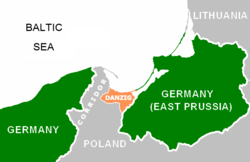Polish Corridor
The Polish Corridor (German: [Polnischer Korridor] Error: {{Lang}}: text has italic markup (help); Polish: [Pomorze, Polski Korytarz] Error: {{Lang}}: text has italic markup (help)), also known as the Danzig Corridor, Corridor to the Sea or Gdańsk Corridor, is a piece of land in the region of Pomerelia (eastern Pomerania, formerly part of West Prussia). It was used by the Second Republic of Poland (1920–1939) for access to the Baltic Sea. The corridor separated much of Germany (Weimar Republic) from East Prussia. At its narrowest point, the corridor was only 30 km wide.[1] It separated The Free City of Danzig (now the Polish city of Gdańsk), from both Poland and Germany.
Creation
The corridor was used to secure Poland's access to the Baltic Sea. This is based on U.S. President Woodrow Wilson's proposal in his famous Fourteen Points speech at the start of 1918.[2] The German-majority city of Danzig was not a part of the Polish Corridor but was instead made a free city under League of Nations rule.[2] Weimar Germany's various governments did not accept the new German-Polish border as being permanent and hoped to change this border later on through negotiations.[3]
Disestablishment
In March 1939, Nazi German dictator Adolf Hitler said that Poland should agree to return Danzig to Germany. He also wanted them to build highways across the Polish Corridor.[2] Poland rejected this proposal and got Anglo-French guarantees against Nazi German aggression.[2] When Nazi Germany invaded Poland in September 1939 over this issue, Britain and France declared war on Nazi Germany and World War II began.[2]
Polish Corridor Media
Polish Prussia in 1466–1772
Majority Polish (green) and German areas in the corridor (German 1910 census)
References
- ↑ Template:GSEn
- ↑ 2.0 2.1 2.2 2.3 2.4 "Polish Corridor - region, Europe". Encyclopedia Britannica.
- ↑ KIMMICH, CHRISTOPH M. (30 April 1969). "The Weimar Republic and the German-Polish Borders". The Polish Review. 14 (4): 37–45. JSTOR 25776872 – via JSTOR.








